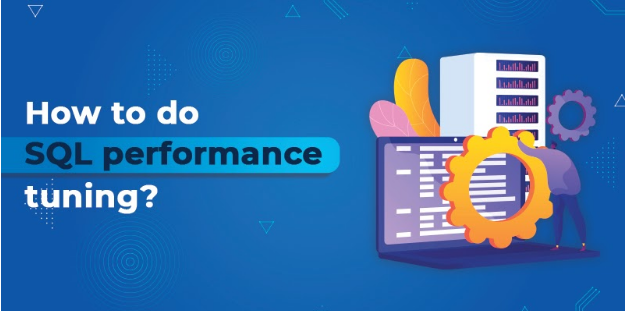TECHNOLOGY
How to Conduct SQL Performance Tuning

How to Conduct SQL Performance Tuning
The concept of SQL Server performance tuning is simple. To put it briefly, if your organization’s functionality involves a lot of powerful tools to handle a range of data, then this system will be the perfect choice for you. It is important to have a properly functioning system to handle data in your organization. For, in a case where the handling system is inefficient, your organization’s resources will be affected.
Other relevant aftermath includes slow performances and the loss of service. This is where the SQL queries come into play; it has the efficiency to smoothen your organization’s functionality when it involves handling data.
By SQL Server performance tuning, you are making the SQL query system more efficient. You can know the concept in depth by enrolling in SQL certification online. The following segment will explain more about the SQL tuning aspect.
SQL performance tuning: a brief understanding
By now, it would be clear that the SQL query system acts as an efficient data warehouse.
But, why does it require tuning? Imagine a general physical warehouse. A warehouse would consist of a variety of shelves, and a number of other elements/ requirements to hold your products properly. Imagine the same physical warehouse being unguarded, in addition to being unattended.
What happens now? All your products could be stolen and could be damaged to a great extent too. Now, imagine this another scenario. You are maintaining the warehouse properly; regularly maintaining the place and attending to small repairs now and then. This would eventually increase the lifetime of your warehouse.
During the course of regular maintenance, you will also make sure that additional products can be added to your warehouse, for more monetary benefits. Likewise, SQL performance tuning gives you more or less the same metamorphic benefits. The better care you give towards the SQL performance tuning, the better the overall SQL performance be.
To simply put, the SQL server generally has a lot of processes as well as procedures; this is to enable efficient functioning of the system. The performance tuning aspect helps in optimizing maximum efficiency in general. Furthermore, the tuning of SQL ensures that MySQL, as well as SQL servers, get benefitted as well.
Importance of SQL performance tuning
- Faster Retrieval
Be it a physical warehouse or SQL data warehouse, the primary aim to store anything is to retrieve it easily. Imagine if it takes hours to get the simplest item from your warehouse; you would be frustrated of course. To be honest, it would be more annoying to sit in front of your workplace device to see the “loading” message. For, you know that a simple delay can alter your day’s schedule to a great extent. To avoid such inconveniences, it is always important to tune the performance of SQL. You can know more about this by checking out SQL interview questions.
Another key point to note here is that, as per several pieces of research conducted across the globe, the speed of your organization’s systems decides your client’s purchasing mood. Thus, the slowness of your SQL performance can impact your client too.
Overall, it is a required action to improve the data retrieval speed of your organization.
- Avoiding coding loops
To put it in simple terms, the concept of coding loops is a set of repetitive instructions. These repetitive instructions continue to happen till the conditional goal/ destination is reached. For an instance, if you want to modify a particular data, the loop will happen only till the modification of data only.
The loops are effective only when it is properly functional. Improper coding loops have the capacity to damage your data. Thus, by tuning the SQL performance, the loop will happen only one time. Without the fine-tuning of the SQL performance, the loop will happen many times, which would have aftermath on your data in general.
Best practices to follow to effectively tune the performance of SQL
- Analyze the task time
The best way to find the health of your server system is by starting your investigation at the task response level. Give your SQL system a simple task to perform and note the time taken. Simultaneously, give a complex task to your system and again note the time. Now check if there is any unreasonable lag as such.
Currently, there are several third-party apps/ software are available that would consistently check the speed of your system and would immediately notify you if there is any suspicious lag.
It is always recommended to record such results and monitor the improvements/ derailments in general.
- Examination is the key
As a part of an organization, you know that every set of data falls under a particular category/ sub-category. Having said that, since you would have to deal with a large chunk of data in general, it is always good to have relevant filters. If you do not have filters as of now, you should seriously consider implementing the same. This will help in fine-tuning the SQL performance to a great level. You can know more about this by checking out the video below:
SQL Certification Training | Learn SQL for Beginners | Intellipaat
Conclusion
Enhancing your SQL is important to keep your data safe and strong. It is also important to improve the overall performance of your database too. By implementing the fine-tuning mechanisms on your database, you are set to have a high-functioning database in your organization.
Author:
Neelabh Verma is a content writer at Intellipaat having 5+ industry experience in databas management
TECHNOLOGY
Next-gen chips, Amazon Q, and speedy S3

AWS re:Invent, which has been taking place from November 27 and runs to December 1, has had its usual plethora of announcements: a total of 21 at time of print.
Perhaps not surprisingly, given the huge potential impact of generative AI – ChatGPT officially turns one year old today – a lot of focus has been on the AI side for AWS’ announcements, including a major partnership inked with NVIDIA across infrastructure, software, and services.
Yet there has been plenty more announced at the Las Vegas jamboree besides. Here, CloudTech rounds up the best of the rest:
Next-generation chips
This was the other major AI-focused announcement at re:Invent: the launch of two new chips, AWS Graviton4 and AWS Trainium2, for training and running AI and machine learning (ML) models, among other customer workloads. Graviton4 shapes up against its predecessor with 30% better compute performance, 50% more cores and 75% more memory bandwidth, while Trainium2 delivers up to four times faster training than before and will be able to be deployed in EC2 UltraClusters of up to 100,000 chips.
The EC2 UltraClusters are designed to ‘deliver the highest performance, most energy efficient AI model training infrastructure in the cloud’, as AWS puts it. With it, customers will be able to train large language models in ‘a fraction of the time’, as well as double energy efficiency.
As ever, AWS offers customers who are already utilising these tools. Databricks, Epic and SAP are among the companies cited as using the new AWS-designed chips.
Zero-ETL integrations
AWS announced new Amazon Aurora PostgreSQL, Amazon DynamoDB, and Amazon Relational Database Services (Amazon RDS) for MySQL integrations with Amazon Redshift, AWS’ cloud data warehouse. The zero-ETL integrations – eliminating the need to build ETL (extract, transform, load) data pipelines – make it easier to connect and analyse transactional data across various relational and non-relational databases in Amazon Redshift.
A simple example of how zero-ETL functions can be seen is in a hypothetical company which stores transactional data – time of transaction, items bought, where the transaction occurred – in a relational database, but use another analytics tool to analyse data in a non-relational database. To connect it all up, companies would previously have to construct ETL data pipelines which are a time and money sink.
The latest integrations “build on AWS’s zero-ETL foundation… so customers can quickly and easily connect all of their data, no matter where it lives,” the company said.
Amazon S3 Express One Zone
AWS announced the general availability of Amazon S3 Express One Zone, a new storage class purpose-built for customers’ most frequently-accessed data. Data access speed is up to 10 times faster and request costs up to 50% lower than standard S3. Companies can also opt to collocate their Amazon S3 Express One Zone data in the same availability zone as their compute resources.
Companies and partners who are using Amazon S3 Express One Zone include ChaosSearch, Cloudera, and Pinterest.
Amazon Q
A new product, and an interesting pivot, again with generative AI at its core. Amazon Q was announced as a ‘new type of generative AI-powered assistant’ which can be tailored to a customer’s business. “Customers can get fast, relevant answers to pressing questions, generate content, and take actions – all informed by a customer’s information repositories, code, and enterprise systems,” AWS added. The service also can assist companies building on AWS, as well as companies using AWS applications for business intelligence, contact centres, and supply chain management.
Customers cited as early adopters include Accenture, BMW and Wunderkind.
Want to learn more about cybersecurity and the cloud from industry leaders? Check out Cyber Security & Cloud Expo taking place in Amsterdam, California, and London. Explore other upcoming enterprise technology events and webinars powered by TechForge here.
TECHNOLOGY
HCLTech and Cisco create collaborative hybrid workplaces

Digital comms specialist Cisco and global tech firm HCLTech have teamed up to launch Meeting-Rooms-as-a-Service (MRaaS).
Available on a subscription model, this solution modernises legacy meeting rooms and enables users to join meetings from any meeting solution provider using Webex devices.
The MRaaS solution helps enterprises simplify the design, implementation and maintenance of integrated meeting rooms, enabling seamless collaboration for their globally distributed hybrid workforces.
Rakshit Ghura, senior VP and Global head of digital workplace services, HCLTech, said: “MRaaS combines our consulting and managed services expertise with Cisco’s proficiency in Webex devices to change the way employees conceptualise, organise and interact in a collaborative environment for a modern hybrid work model.
“The common vision of our partnership is to elevate the collaboration experience at work and drive productivity through modern meeting rooms.”
Alexandra Zagury, VP of partner managed and as-a-Service Sales at Cisco, said: “Our partnership with HCLTech helps our clients transform their offices through cost-effective managed services that support the ongoing evolution of workspaces.
“As we reimagine the modern office, we are making it easier to support collaboration and productivity among workers, whether they are in the office or elsewhere.”
Cisco’s Webex collaboration devices harness the power of artificial intelligence to offer intuitive, seamless collaboration experiences, enabling meeting rooms with smart features such as meeting zones, intelligent people framing, optimised attendee audio and background noise removal, among others.
Want to learn more about cybersecurity and the cloud from industry leaders? Check out Cyber Security & Cloud Expo taking place in Amsterdam, California, and London. Explore other upcoming enterprise technology events and webinars powered by TechForge here.
TECHNOLOGY
Canonical releases low-touch private cloud MicroCloud

Canonical has announced the general availability of MicroCloud, a low-touch, open source cloud solution. MicroCloud is part of Canonical’s growing cloud infrastructure portfolio.
It is purpose-built for scalable clusters and edge deployments for all types of enterprises. It is designed with simplicity, security and automation in mind, minimising the time and effort to both deploy and maintain it. Conveniently, enterprise support for MicroCloud is offered as part of Canonical’s Ubuntu Pro subscription, with several support tiers available, and priced per node.
MicroClouds are optimised for repeatable and reliable remote deployments. A single command initiates the orchestration and clustering of various components with minimal involvement by the user, resulting in a fully functional cloud within minutes. This simplified deployment process significantly reduces the barrier to entry, putting a production-grade cloud at everyone’s fingertips.
Juan Manuel Ventura, head of architectures & technologies at Spindox, said: “Cloud computing is not only about technology, it’s the beating heart of any modern industrial transformation, driving agility and innovation. Our mission is to provide our customers with the most effective ways to innovate and bring value; having a complexity-free cloud infrastructure is one important piece of that puzzle. With MicroCloud, the focus shifts away from struggling with cloud operations to solving real business challenges” says
In addition to seamless deployment, MicroCloud prioritises security and ease of maintenance. All MicroCloud components are built with strict confinement for increased security, with over-the-air transactional updates that preserve data and roll back on errors automatically. Upgrades to newer versions are handled automatically and without downtime, with the mechanisms to hold or schedule them as needed.
With this approach, MicroCloud caters to both on-premise clouds but also edge deployments at remote locations, allowing organisations to use the same infrastructure primitives and services wherever they are needed. It is suitable for business-in-branch office locations or industrial use inside a factory, as well as distributed locations where the focus is on replicability and unattended operations.
Cedric Gegout, VP of product at Canonical, said: “As data becomes more distributed, the infrastructure has to follow. Cloud computing is now distributed, spanning across data centres, far and near edge computing appliances. MicroCloud is our answer to that.
“By packaging known infrastructure primitives in a portable and unattended way, we are delivering a simpler, more prescriptive cloud experience that makes zero-ops a reality for many Industries.“
MicroCloud’s lightweight architecture makes it usable on both commodity and high-end hardware, with several ways to further reduce its footprint depending on your workload needs. In addition to the standard Ubuntu Server or Desktop, MicroClouds can be run on Ubuntu Core – a lightweight OS optimised for the edge. With Ubuntu Core, MicroClouds are a perfect solution for far-edge locations with limited computing capabilities. Users can choose to run their workloads using Kubernetes or via system containers. System containers based on LXD behave similarly to traditional VMs but consume fewer resources while providing bare-metal performance.
Coupled with Canonical’s Ubuntu Pro + Support subscription, MicroCloud users can benefit from an enterprise-grade open source cloud solution that is fully supported and with better economics. An Ubuntu Pro subscription offers security maintenance for the broadest collection of open-source software available from a single vendor today. It covers over 30k packages with a consistent security maintenance commitment, and additional features such as kernel livepatch, systems management at scale, certified compliance and hardening profiles enabling easy adoption for enterprises. With per-node pricing and no hidden fees, customers can rest assured that their environment is secure and supported without the expensive price tag typically associated with cloud solutions.
Want to learn more about cybersecurity and the cloud from industry leaders? Check out Cyber Security & Cloud Expo taking place in Amsterdam, California, and London. Explore other upcoming enterprise technology events and webinars powered by TechForge here.
-

 PPC6 days ago
PPC6 days agoHow the TikTok Algorithm Works in 2024 (+9 Ways to Go Viral)
-

 SEO5 days ago
SEO5 days agoHow to Use Keywords for SEO: The Complete Beginner’s Guide
-

 MARKETING6 days ago
MARKETING6 days agoHow To Protect Your People and Brand
-

 MARKETING4 days ago
MARKETING4 days agoAdvertising on Hulu: Ad Formats, Examples & Tips
-

 MARKETING5 days ago
MARKETING5 days agoUpdates to data build service for better developer experiences
-

 MARKETING5 days ago
MARKETING5 days agoThe Ultimate Guide to Email Marketing
-

 SEO7 days ago
SEO7 days agoAutomate Multi-Site Reporting With Google Sheets And GSC API
-

 MARKETING23 hours ago
MARKETING23 hours ago18 Events and Conferences for Black Entrepreneurs in 2024









You must be logged in to post a comment Login